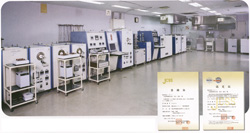CHINO Calibration Service

For traceable temperature and humidity measurement and maintaining sensor accuracy
- We operate our business in a fair and neutral manner with appropriate quality and technology.
- We comply with quality systems such as ISO9000, ISO14000, and IATF16949, and help ensure traceability to national standards.
Calibration test & temperature calibration equipment catalogue is here
What is calibration testing? About Chino calibration testing
Calibration (testing) is defined in the JIS as "a series of operations to determine the relationship between the values indicated by the instrument or measurement system, or the values represented by the actual instrument or reference material, and the values realized by the standard."
In other words, it is a task to check the difference between the measurement object and the standard (instrument) and to see how much the measurement object deviates from the standard (instrument).
At that time, if it deviates from the standard or the (accepted) standard set by the manufacturer, it will be rejected or non-conforming, and repair, readjustment, or replacement with a new product will be recommended.
The frequency and frequency of calibration is determined by the company that uses the sensor, and in most cases, it is determined by the quality assurance department of the company.
In some cases, the manufacturer recommends a calibration frequency.
We recommend that you calibrate your instruction manual once a year.
In addition, there are two types of calibration tests performed by our company: "Chino calibration" performed according to our standards, and "JCSS calibration test" conducted by a calibration company registration by the National Institute of Technology and Evaluation (NITE) under the registration system of calibration companies under the metrology method calibration business system, based on the specified conditions of the sensor and calibration conditions.
As a calibration company registration under the registration system of measurement calibration companies mentioned above, we conduct "Chino calibration" and "JCSS calibration test".
What is the JCSS Calibration Test?
What is traceability?
The JIS defines traceability as "the property of a measurement result or standard value that can be linked to an established standard by an unbroken chain of comparisons, with all uncertainties stated. The standard is usually a national or international standard."
Simply put, it is to prove that the measurement results and uncertainties of the sensor readings (values) used in business can be traced back to national or international standards.
This means that it is possible to confirm what range the value indicated by the target sensor falls within. This document is called a traceability certificate.
Calibration is necessary to ensure the reliability of measurements made by manufacturers, testing and research institutions, other industries, and the general public. Furthermore, calibration (or inspection) of measuring instruments is also a mandatory requirement in the laws, standards, and quality management systems related to each industry.
Please refer to Traceability for more information.
CHINO standard calibration
Comparison calibration (temperature sensor)
Fixed-point calibration (temperature sensor)
*The triple point of argon is an interpolated value based on the boiling point of nitrogen (approximately -196°C), the triple point of mercury, and the triple point of water.
Electronic hygrometer/dew point meter


